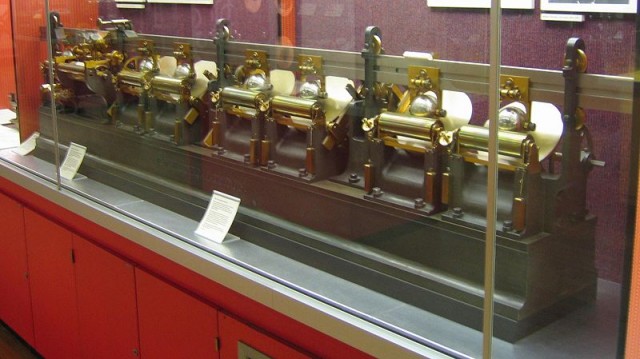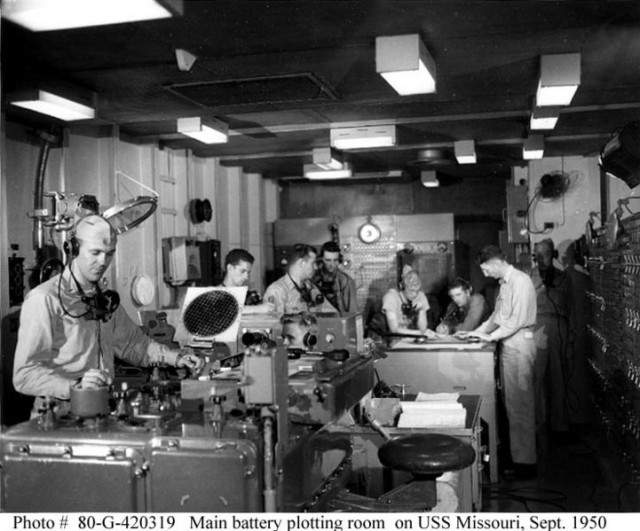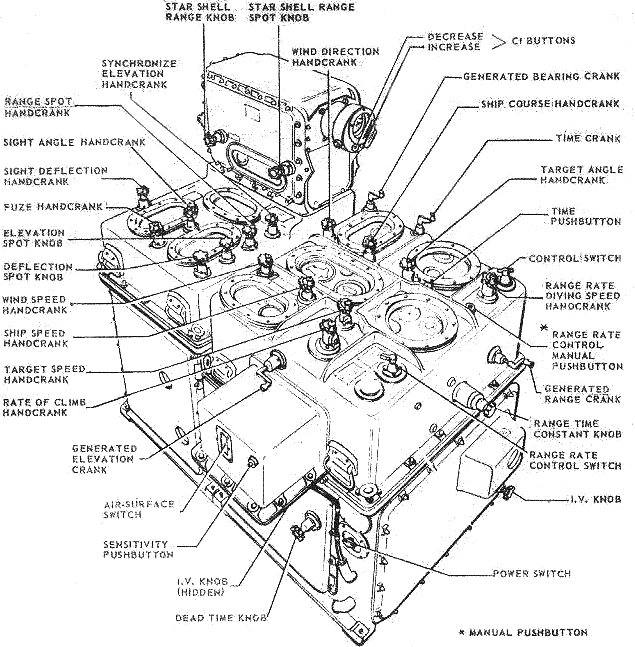We are resurfacing this feature from 2014 for your reading pleasure on this holiday weekend.
The USS Zumwalt, the latest destroyer now undergoing acceptance trials, comes with a new type of naval artillery: the Advanced Gun System (AGS). The automated AGS can fire 10 rocket-assisted, precision-guided projectiles per minute at targets over 100 miles away.
Those projectiles use GPS and inertial guidance to improve the guns accuracy to a 50 meter (164 feet) circle of probable error—meaning that half of its GPS-guided shells will fall within that distance from the target. But take away the fancy GPS shells, and the AGS and its digital fire control system are no more accurate than mechanical analog technology that is nearly a century old.
We're talking about electro-mechanical analog fire control computers like the Ford Instruments Mark 1A Fire Control Computer and Mark 8 Rangekeeper. These machines solved 20-plus variable calculus problems in real-time, constantly, long before digital computers got their sea legs. They were still in use when I served aboard the USS Iowa in the late 1980s.
There were a few efforts to marry these older systems to or replace them with digital technology during my tour, one of which (called the Advanced Gun Weapon System Technology Program) was remarkably like the AGSs 100-mile shell: a GPS and inertially guided 11-inch dart-shaped shell wrapped in a 16-inch peel-away jacket, or sabot, that would have been able to fly nearly as far without the rocket assist thanks to the battleships big guns.
So why did the Navy never follow through with digitizing the battleships big guns? I asked retired Navy Captain David Boslaugh, former director of the Navy Tactical Embedded Computer Program Office, that question. And if anyone would know, it's Boslaugh. He played a role in the development of the Navy Tactical Data System—the forerunner to todays Aegis systems, the mother of all digital sensor and fire control systems.
“At one time, my office was asked to do a study regarding upgrading the Iowa-class battleship fire control systems from analog to digital computers,” Boslaugh replied. “We found that digitizing the computer would improve neither the reliability nor the accuracy of the system and recommended, Don't bother.” Even without digital computers, the Iowa could fire 2,700-pound “dumb” shells nearly 30 miles inland with deadly accuracy, within a circle of probable error of around 80 meters. Some of its shells had circles of destruction larger than that.
Just how can a box of gears, cams, racks, and pins handle ballistics calculations based on differential equations with dozens of variables in real time? How does it manage to put a hunk of metal weighing as much as a Volkswagen Beetle on top of a target over the horizon in the first place? And how did this metal and grease out-calculate digital systems for so long? Let's start with a little bit of a history on battleship ballistics—complete with vintage Navy training films to show precisely how mechanical analog computing works.
Going ballistic
Shooting things with a gun from a ship is not exactly easy. In addition to the usual problems faced by ballistics—calculating how much bang to apply, how high to aim to reach a target at a certain range, how much to compensate for wind and the Coriolis effect—you have to take into account the fact that youre shooting from a platform that has constantly changing pitch, yaw, and position. If youre lucky enough to have a stationary target, the variables are still comparable to trying to hit something with a water balloon from the back of a hopping kangaroo.
Shooting things within sight of a ship is a feedback loop. Aim at the target, calculate its relative movement and other ballistic conditions, shoot, watch where the shot falls, and adjust. Shooting targets over the horizon is even trickier. It requires a forward observer who can give a precise geographic fix and then give corrections based on where shells land to walk them onto target.
In the days before turrets, ships fired guns in broadsides. Adjustments were generally made by where the shells fell and by waiting to fire until the side facing the enemy was on the upward side of a roll. But with the arrival of dreadnoughts and battle cruisers at the beginning of the 20th century, the range and lethality of ships guns both rose dramatically. There was now a greater need for accuracy, too.
That need corresponded with the rise of analog computers. Mechanical analog computers were used by astronomers for centuries to predict star positions, eclipses, and the phases of the moon—the earliest known mechanical analog computer, called the Antikythera Mechanism, dated to 100 BC. But nobody got around to using computers to try to kill people until much later.
Analog computers use a common set of mechanical devices to do their calculations—the same sorts of devices that convert the torque created by a cars engine into turning wheels, lifting valves, and moving pistons. Data is “entered” into analog computers continuously, usually by the rotation of shaft inputs. A mathematical value is assigned to one full 360-degree rotation of the shaft.
In the days of the ancient Greeks, data entry was performed by turning a wheel. In more modern analog computers, variables from sensor data such as speed, direction, wind speed, and other factors were passed by electromechanical connections—synchro signals from gyrocompasses and gyroscopic “stable verticals,” tracking systems, and speed sensors. Constants, like passing time, were input by special constant-speed electrical motors.
Connecting all the shafts together to turn them into a continuous set of calculation outputs is a collection of gears, cams, racks, pins, and other mechanical elements that translate motion into math through geometric and trigonometric principles. This is also done through “hard-coded” functions that store the results of more complex calculations in their precisely machined shapes. Working together, these parts instantaneously calculate a very precise answer to a very specific set of questions: where will the target be when the giant bullet I push out of a 68-foot long rifled barrel gets there, and where do I need to aim to get it there?
When assembled precisely, analog computers can be much more accurate than digital computers on these types of questions. Because they use physical rather than digital inputs and outputs, they can represent curves and other geometric elements of calculations with an infinite level of resolution (though the precision of those calculations is based on how well their parts are machined, and loss from friction and slippage). There are no least significant digits dropped, and answers are continuous rather than dependent on “for-next” clock-driven computing cycles.
Coding in metal
The most fundamental part of any mechanical analog computer is its gears. By using combinations of gears of various types, an analog computer can perform basic mathematical functions such as addition, subtraction, multiplication, and division.
Gear ratios—the use of two gears with circumferences that are a fixed multiple or fraction of each other—are the most basic way to do math with machines. They can be used to scale input or output up or down or to apply constant multiples of an input to another calculation. Turn a shaft geared to another with a 2-to-1 ratio, for example, and the shaft getting the output rotates half as many times.
Rack-and-pinion systems like those used in steering your car are also used in analog computers to translate rotational motion to a linear output—moving a readout or positioning components to solve other sorts of calculations in the ballistics problem geometrically.
You can get an idea of how these sorts of gear-based systems work in analog computers in this clip from a 1953 Navy training film on fire control computers:
Differential gears are used in cars to make it possible for wheels to rotate at different speeds in turns. But they perform a different function in analog computers, providing a mechanical way to perform addition and subtraction. A set of differential gears set between two input shafts with matching gears will always make a set of rotations that is the mathematical average of the rotations of the two inputs; multiply that average by two and you have the algebraic sum of the two inputs. For example, if one input shaft spins forward three times and the other spins forward once, the differential gears will rotate their attached shaft twice—which is half of four, the total.
All that is fine for basic math. But for higher level functions, such as calculating things like ballistic trajectory curves or the Coriolis effects impact on longer-flying shells, analog computers need more complicated parts. Some of those functions can be handled by cams—rotating surfaces that have been machined to “store” the answers for a range of values. Simple cams can store a range of answers based on a single variable, such as turning an input rotation into a trigonometric or logarithmic output through the movement of a pin connected to a rack. More complex, three-dimensional “barrel” cams can store answers to complex two-variable functions as a rotational volume, as demonstrated in the film clip below.
All of these components were well-known to the makers of early celestial calculators, though their machining may not have been nearly as precise as could be achieved with the tools of the Industrial Age. But theres one last mechanical component that brought everything together for the advanced calculations required in predicting a targets location in ballistic calculations: the integrator. It's a device that uses the differing rates of rotation on a spinning disc to act as an infinitely variable differential gear.
First fully developed by Prof. James Thompson of Belfast in 1876, the integrator was further refined by his brother Lord Kelvin as the element of a “harmonic analyzer.”

Lord Kelvin used the harmonic analyzer to isolate the multiple factors affecting tidal patterns so they could be predicted in the future. The computer took in two inputs: time was input as a steady rotation, while the tide height was traced from a recording with a mechanical needle. Wires and pulleys generated the output, drawing a curve on a roll of paper. The Royal Navy loved Kelvins tide computer because it allowed them to take historic tide data recorded anywhere in the world and generate tide tables with a fraction of the work. More than a half-century later, Lord Kelvins tide computers helped in planning the D-Day landings at Normandy, thus contributing directly to the outcome of World War II.
Aside from refinements to make it more reliable under the demanding conditions of shipboard operation, the integrators in fire control computers in operation through the 1990s were essentially the same as those used by Lord Kelvin in function, as shown in the video below. Hannibal Ford, the man who designed the Rangekeeper and Mark 1 fire control computers, invented this improved integrator, which uses a pair of balls in a carriage to transmit rotation information from the turning disc.
The network is the (fire control) computer
The fire control “systems” of the First World War were largely standalone pieces connected by people shouting over phones and voice tubes. The only data that came into the Rangekeeper Mark I automatically was the ships course, thanks to a gyrocompass repeater. That would change over the next decade as the navies of the world got more comfortable with this newfangled thing called electricity.
The Washington Naval Treaty of 1922 ratcheted back naval development for nearly a decade, but Ford continued the development of the Rangekeeper through the '20s, culminating in 1930 with the Rangekeeper Mark 8. The Mark 8 would be the zenith of big naval gun fire control. It was the system used aboard Iowa-class battleships to direct the ships 16-inch guns, and it calculated every broadside from the four ships since their commissioning in World War II until their bombardment of Iraqi troops in the Gulf War in February of 1991.

The Rangekeeper Mark 8 still gave operators the option of manually entering data just in case a connection to a sensor failed, and they could also override or adjust data based on observation of shot and other corrections. The machine could even be operated without electricity by turning a hand crank. Target bearing and range now came in as electrical inputs from a gun director. A ships speed was fed in using data from the ships pitot tube automatically, and wind speed was inputted directly from an anemometer.
Once the system was “locked” on a target, the Mark 8 would send signals through a switchboard to the gun turrets and mounts to keep them aimed properly, next sending stabilizing data to adjust the elevation of the guns for the ships yaw and pitch. The Mark 8 was itself electromechanically networked. It consisted of five boxes of analog computing hardware bolted together into a single unit.
The Mark 8 was for the big guns, which were strictly for surface targets because of their size and rate of fire. Smaller guns, like the 5-inch 38 caliber dual-gun mounts on the Iowa and many of the other smaller warships of the World War II era, needed to be able to target faster, smaller targets in three dimensions—plainly speaking, airplanes. This required much more complex calculations, leading to the pinnacle of electromechanical analog computing: the Ford Instruments Mark 1 Fire Control computer.

The Mark 1 weighed over 3,000 pounds. Like the Rangekeeper, it took inputs from gun directors—electromechanically driven turret-like “barbettes” with optical (and eventually radar) sensors that continuously sent bearing and range information via electrical synchro signals.
The computer took into account parallax between the director and the guns it was controlling. It also had to calculate fuse times for mechanical fuses to ensure that the shell would explode near the target. (That said, there were a few times in gunnery practice in the 1980s when the Iowa directly hit a towed aerial target, albeit not on purpose.)
Considered to be the most accurate anti-aircraft computer in service during the war, the Mark 1 still had some serious limitatioRead More – Source
[contf] [contfnew] 
arstechnica
[contfnewc] [contfnewc]






